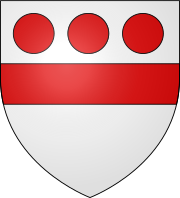Viscount Hereford
| Viscountcy of Hereford | |
|---|---|
 
Argent, a fess gules in chief three torteaux
|
|
| Creation date | 2 February 1550 |
| Monarch | Edward VI |
| Peerage | Peerage of England |
| First holder | Walter Devereux, 9th Baron Ferrers of Chartley |
| Present holder | Robin Devereux, 19th Viscount Hereford |
| Heir apparent | The Hon. Henry Devereux |
| Remainder to | Heirs male of the first viscount's body, lawfully begotten |
| Former seat(s) |
Hampton Court Castle Bromwich Hall |
| Armorial motto | Virtutis comes invidia ("Envy is the attendant of virtue") |
Viscount Hereford is the oldest extant viscountcy in the Peerage of England, making the holder the Premier Viscount of England. The title was created in 1550 for Walter Devereux, 9th Baron Ferrers of Chartley.
The Devereux (/ˈdɛvəruːks/) family is of Norman descent and came to England after the Norman conquest in 1066 – this branch lorded over Lyonshall and Bodenham, Herefordshire as their main estates. Sir Walter Devereux (d. 1485), married Anne Ferrers, 7th Baroness Ferrers of Chartley (d.1469) (see the Baron Ferrers of Chartley for earlier history of this title). He was summoned to Parliament as Lord Ferrers of Chartley in her right. Devereux was killed at the Battle of Bosworth in 1485, fighting on the side of King Henry VII. Their son, the eighth Baron, married Cicely, daughter of William Bourchier, Viscount Bourchier, son of Henry Bourchier, 1st Earl of Essex and 5th Baron Bourchier) (see the Baron Bourchier for more information on the Bourchier family). He was succeeded by his son, the ninth Baron who served with distinction in the French Wars of King Henry VIII and was honoured in 1550 when he was created Viscount Hereford in the Peerage of England.
He was succeeded by a grandson, the son of his second son, Hon. Sir Richard Devereux. This latter Walter Devereux was also a prominent soldier during the reign of Queen Elizabeth I. Lord Hereford was a Field Marshal of the forces sent to quell the Northern Rebellion of 1569 and led an expedition to occupy Ulster in 1573. In 1570 he succeeded his first cousin twice removed as eighth Baron Bourchier in right of his great-grandmother Cecily Bourchier. In 1572 the earldom of Essex held by the Bourchier family (which had become extinct in 1540) was revived when he was created Earl of Essex in the Peerage of England. On his death the titles passed to his son Robert, the second Earl. He was the highly trusted courtier, soldier and favourite of Queen Elizabeth I. However, Lord Essex after many years defied the Queen and tried to raise a rebellion in London. He was condemned to death for high treason and beheaded in the Tower of London on 25 February 1601. His titles were forfeited.
...
Wikipedia
